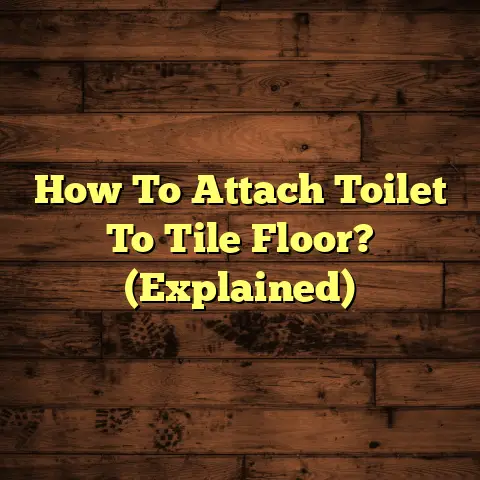Cat Poop on Floor? (1-Minute Stain Rescue!)
Ever walked into your living room, ready to relax after a long day, only to be greeted by… that?
Yeah, I’m talking about the dreaded discovery of cat poop on your beautiful floor.
I’ve been there, knee-deep in flooring for over 15 years, and let me tell you, it’s a moment that can trigger a range of emotions, from “ugh, not again!” to a full-blown “how am I ever going to get this clean?!”
But here’s the good news: it doesn’t have to be a flooring disaster.
I’m going to share my secrets for a “1-minute stain rescue” – a game-changer that can help you tackle this messy problem quickly and effectively.
Trust me, with the right knowledge and tools, you can transform that initial shock and frustration into a manageable task and get back to enjoying your furry friend.
Let’s dive in!
Section 1: Understanding the Issue
Okay, first things first. Why do cats sometimes decide the litter box isn’t the place to do their business?
It’s not always just them being naughty (though sometimes, it feels that way, right?).
There are several reasons:
-
Health Issues: Urinary tract infections (UTIs), kidney problems, or other medical conditions can make it difficult for your cat to make it to the litter box in time. If you suspect a health issue, a vet visit is a must.
-
Behavioral Problems: Stress, anxiety, or territorial marking can also lead to accidents outside the litter box. Think about any recent changes in your cat’s environment – new pet, new baby, moving furniture, etc.
-
Litter Box Issues: This is a big one. Is the litter box clean enough? Is it the right size for your cat? Do they like the type of litter you’re using? Cats can be picky!
According to the American Association of Feline Practitioners, even subtle changes in the litter box environment can deter a cat from using it properly.
Now, regardless of the reason, one thing is certain: you need to address the mess promptly. The longer cat poop sits on your floor, the greater the chance of stains and odors setting in.
And trust me, those odors can be tough to get rid of!
Section 2: The Essential Toolkit for Cat Poop Clean-Up
Alright, time to gear up for our 1-minute stain rescue! Here’s what you’ll need:
-
Gloves: Trust me, you don’t want to touch this stuff with your bare hands. I always keep a box of disposable gloves handy.
-
Paper Towels: The workhorse of any clean-up. Choose a strong, absorbent brand.
-
Enzymatic Cleaner: This is the key to getting rid of the stain and odor. Enzymatic cleaners contain enzymes that break down the organic matter in cat poop, eliminating the source of the smell. Don’t use regular cleaners with bleach – they can actually set the stain and react with the ammonia in cat urine, making the odor even worse! My go-to is Nature’s Miracle.
-
Baking Soda: An optional but highly recommended addition. Baking soda is a natural deodorizer that can help absorb any lingering odors.
-
Spray Bottle (Optional): If your enzymatic cleaner doesn’t come in a spray bottle, you’ll need one to apply it effectively.
-
Soft Cloth or Sponge: For gently blotting the area after applying the cleaner.
-
Small Trash Bag: For disposing of the soiled paper towels and gloves.
Why these items?
Well, gloves protect you. Paper towels remove the bulk of the mess. The enzymatic cleaner breaks down the waste at a molecular level.
Baking soda absorbs lingering odors, and the soft cloth ensures you’re gentle on your flooring.
Think of this toolkit as your superhero arsenal against cat poop chaos!
Section 3: The 1-Minute Stain Rescue Step-by-Step Guide
Okay, here we go! Time to put our toolkit to work. Remember, the goal is to act fast and minimize the damage.
Step 1: Preparation (5 seconds)
- Grab your gloves and put them on.
- Gather your paper towels, enzymatic cleaner, and trash bag.
Step 2: Initial Clean-Up (20 seconds)
- Carefully blot up as much of the cat poop as possible with the paper towels.
- Avoid rubbing the mess, as this will only spread it further into the flooring.
- Work from the outside in, gently lifting the waste.
- Dispose of the soiled paper towels in the trash bag.
Step 3: Application of Cleaner (20 seconds)
- Spray the affected area generously with the enzymatic cleaner.
- Make sure to saturate the stain thoroughly.
- Follow the instructions on the cleaner’s label. Most recommend letting the cleaner sit for 5-10 minutes to allow the enzymes to do their work. But for our 1-minute rescue, we’re going to cheat a little.
Step 4: Deodorizing (10 seconds)
- Sprinkle a generous amount of baking soda over the wet area.
- The baking soda will help absorb any remaining moisture and odors.
Step 5: Final Touches (5 seconds)
- Let the area dry completely.
- This could take a few hours, depending on the humidity and the type of flooring.
- Once dry, vacuum up the baking soda.
And that’s it! You’ve successfully completed your 1-minute stain rescue.
Now, I know what you’re thinking: “But wait, the enzymatic cleaner needs to sit for longer than one minute!”
You’re right. However, the key is to immediately remove the bulk of the mess and apply the cleaner. This prevents the stain and odor from setting in. You can always come back later and reapply the cleaner if needed.
Section 4: Quick Tips for Different Flooring Types
Now, let’s talk specifics. The cleaning process may vary slightly depending on your flooring type. Here’s a quick rundown:
-
Hardwood: Hardwood is porous, so it’s crucial to act fast. Blot up the mess immediately and apply the enzymatic cleaner. Avoid using excessive water, as this can damage the wood. After cleaning, consider applying a wood floor cleaner and polish to restore the shine.
- Pro Tip: If the stain is old or stubborn, you might need to sand and refinish the affected area.
-
Tile: Tile is generally more resistant to stains than other flooring types. However, the grout can be porous and absorb odors. Make sure to clean the grout thoroughly with a grout brush and the enzymatic cleaner.
- Pro Tip: For stubborn grout stains, try making a paste of baking soda and water and applying it to the grout. Let it sit for a few hours, then scrub with a brush and rinse.
-
Carpet: Carpet is the most challenging flooring type to clean cat poop from, as the fibers can easily trap stains and odors. Blot up as much of the mess as possible, then apply the enzymatic cleaner generously. Use a soft cloth or sponge to gently blot the area, working from the outside in. Avoid rubbing, as this can damage the carpet fibers. After cleaning, consider using a carpet cleaner to remove any remaining residue.
- Pro Tip: Place a thick layer of paper towels over the cleaned area and weigh it down with a heavy object. This will help absorb any remaining moisture and odors.
-
Laminate: Laminate is relatively easy to clean, but it’s important to avoid excessive moisture, as this can damage the seams. Blot up the mess immediately and apply the enzymatic cleaner. Use a soft cloth or sponge to gently wipe the area.
- Pro Tip: Use a laminate floor cleaner after cleaning to restore the shine and protect the flooring.
No matter what type of flooring you have, always test the enzymatic cleaner in an inconspicuous area first to make sure it doesn’t discolor or damage the surface.
Section 5: Preventing Future Accidents
Okay, we’ve tackled the immediate mess. But what about preventing future accidents? Here are some tips:
-
Litter Box Maintenance: This is the most important factor. Scoop the litter box at least once a day, and change the litter completely every week or two.
- Did you know? According to a study published in the Journal of Veterinary Behavior, cats are more likely to use a clean litter box.
-
Litter Box Location: Make sure the litter box is in a quiet, accessible location, away from food and water. Avoid placing it in a high-traffic area or near loud noises.
-
Litter Box Type: Experiment with different types of litter boxes to see what your cat prefers. Some cats prefer covered litter boxes, while others prefer open ones. Also, try different types of litter – clay, crystal, or natural.
-
Number of Litter Boxes: A good rule of thumb is to have one litter box per cat, plus one extra. So, if you have two cats, you should have three litter boxes.
-
Behavioral Training: If your cat is spraying or marking, you might need to consult with a veterinarian or a certified cat behaviorist. They can help you identify the underlying cause of the behavior and develop a training plan.
-
Health Checks: As I mentioned earlier, health issues can sometimes cause cats to have accidents outside the litter box. Regular vet checkups can help identify and treat any underlying medical conditions.
Creating a comfortable and stress-free environment for your cat is key to encouraging them to use their litter box consistently.
Section 6: Personal Stories of Transformation
Let me share a couple of stories from pet owners who faced similar challenges and found success with the 1-minute stain rescue method:
-
Sarah, a busy working mom, was constantly frustrated by her cat, Whiskers, who would occasionally have accidents on her new hardwood floors. “I was at my wit’s end,” she told me. “I tried everything – different litters, different litter boxes, even those pheromone diffusers. Nothing seemed to work.” Then, she discovered the 1-minute stain rescue method. “It was a game-changer!” she exclaimed. “Now, whenever Whiskers has an accident, I can clean it up quickly and easily, without having to worry about stains or odors. It’s made such a difference in my stress level!”
-
John, a retired teacher, adopted a senior cat, Mittens, who had some mobility issues. “Mittens sometimes had trouble making it to the litter box in time,” he explained. “I felt so bad for her, but I was also worried about my carpets.” John started using the enzymatic cleaner and baking soda method. “It worked like a charm!” he said. “The stains and odors disappeared, and Mittens seemed much more comfortable.”
These stories highlight the emotional relief and satisfaction that comes with effective cleaning and maintenance. It’s not just about removing the mess; it’s about restoring peace of mind and strengthening the bond with your furry friend.
Conclusion: Embracing the Journey of Pet Ownership
Having a cat is a wonderful experience, filled with love, companionship, and endless entertainment.
But let’s be honest, it also comes with its fair share of challenges – including the occasional cat poop incident.
The key is to remember that accidents happen. It’s part of the journey of pet ownership.
But with the right knowledge, tools, and a little bit of patience, you can transform stressful situations into manageable tasks.
The 1-minute stain rescue method is a simple yet effective way to tackle cat poop on your floor, allowing you to enjoy your furry friend without the worry of messes.
So, embrace the ups and downs of pet ownership, and remember that you’re not alone. We’ve all been there!
Call to Action
Now it’s your turn! What are your favorite tips and tricks for dealing with cat accidents? Share your experiences in the comments below! Let’s create a community of pet owners helping each other navigate the challenges of cat ownership.
And if you found this article helpful, please share it with your fellow cat lovers!





